
Hello, howdy, and welcome one and all to the inaugural issue of Breaking Ground, the column where I, Michael “BS” Barnes, belittle established Vs. System personalities.* And when I’m not doing that, I’ll look at some of the lesser appreciated cards in the Vs. System (i.e. “jank”) and examine new and interesting ways to “break the card.”
You may ask, “What exactly do you mean by ‘break the card?’” I think we have all had at least one moment in our Vs. System life when we saw a particular card for the first time and said, “Ohmygawd! That card is bah-roken!” However, we found as time went by that we really couldn’t find a way to turn that little gem of unfulfilled potential into the Next Big Thing. So, we went back to abusing opponents with purple robots, and our one-time phenomenon remained lonely in our trade binders.
Well, no more! It’s time that these cards live up to their potential, so we’re gonna break ’em! Before you know it, you’ll have opponents scratching their heads and wondering how on Earth you can possibly abuse them so badly with such “garbage.”**
Keep in mind that we will be traversing the narrow road from theory to functionality. In other words, the ideas that we examine for our little jank jewels will be highly speculative. However, our goal here is not to develop the next tier 1 deck with which to terrorize the Vs. System. Rather, we are going to look at the potential for individual cards and develop builds based around them. The decks we develop may or may not be competitive, but there should be little doubt that our crazy builds will be unique, insightful, and—most importantly—fun!
Burning Down the House
For the first column, I really wanted to find a card that not only has received less than its fair share of attention (much like Ryan Jones at a Pro Circuit), but also one that would inspire a deck that is up to my insane standards—a hefty task, to say the least.***
Since I started playing Vs. System all the way back in Marvel Origins, I have been fascinated with the concept of “burn” decks. For those of you unfamiliar with the term, burn refers to effects that reduce an opponent’s endurance without attacking. Several competitive decks have incorporated burn elements, such as Teen Titans with Red Star and New School with Glorious Godfrey. However, there hasn’t really been a competitive deck with burn as its primary focus.
One of my pet decks back when Marvel Origins was the only legal set was a Mutant Nation burn deck (very similar to one built by Ben Kalman, or as I like to call him, “Insufferable Know-It-All Canadian” . . . um . . . I mean “Kergillian”). The key to the deck was to team up X-Men and Brotherhood and then rely on the powerful burn cards of the Brotherhood to reduce your opponent’s endurance quickly with some assistance from the X-Men. Two of the central combos in the deck were: 1) Dazzler exhausting an opponent’s support row character followed by a Quicksilver, Pietro Maximoff activation; and 2) Destiny activating to name a 3-drop and then using Gambit to stun said 3-drop.
 If Xavier’s School for Gifted Youngsters was on the board along with a team-up, either combo would yield at least 10 points of endurance loss every turn. Toss in the Pyro and Advanced Hardware activations, effective plays of The Mutant Menace and Surprise Attack, and the continuous burn of War on Humanity, and your games usually wouldn’t last past turn 5.
If Xavier’s School for Gifted Youngsters was on the board along with a team-up, either combo would yield at least 10 points of endurance loss every turn. Toss in the Pyro and Advanced Hardware activations, effective plays of The Mutant Menace and Surprise Attack, and the continuous burn of War on Humanity, and your games usually wouldn’t last past turn 5.
Of course, time marches on and new set releases inevitably lead to exploration into new decks. Once DC Origins came into being, I pretty much left my burn deck behind to explore the wonderful world of The Brave and the Bold.
The Unforgettable Fire
The release of the Green Lantern Corps set got me back to thinking about burn effects. You see, there were four very unique and powerful cards released in Green Lantern Corps—three ongoing plot twists and one location. These cards had a hefty cost to activate in that the player was required to exhaust four characters. However, the effects gleaned from these cards were potentially game-breaking. Unfortunately, none of these cards were, at least to my knowledge, ever utilized to their full potential.
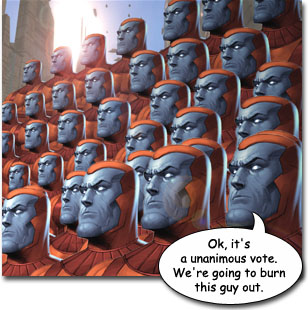 The card that caught my eye was the one for the Manhunters team, Council of Power. It’s an ongoing plot twist with a threshold cost of 2 that reads, “As an additional cost to flip Council of Power, exhaust four characters you control. Ongoing: At the start of the recovery phase, if you control a Manhunter character, each of your opponents loses 2 endurance for each card in his hand, then gains 2 endurance for each card in your hand.”
The card that caught my eye was the one for the Manhunters team, Council of Power. It’s an ongoing plot twist with a threshold cost of 2 that reads, “As an additional cost to flip Council of Power, exhaust four characters you control. Ongoing: At the start of the recovery phase, if you control a Manhunter character, each of your opponents loses 2 endurance for each card in his hand, then gains 2 endurance for each card in your hand.”
Intriguing. Against decks with which players typically hold massive numbers of cards in hand, such as Cosmic Cops and Force, this card has the potential to end the game before the opponent can ever gain board presence.
Of course, this assumes that the player controlling Council of Power has few to no cards in hand. And, as any knowledgeable Vs. player will tell you, playing without cards in your hand is suicide . . . right?
Something Unexpected This Way Comes
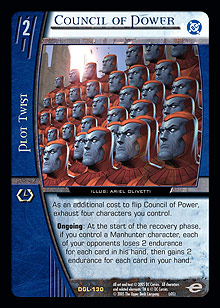 Just as the Marvel Knights set brought us the X-Statix loner strategy, the Avengers set brought us a team with a very unique play style—Squadron Supreme. Along with an alternate theme of breakthrough replacement effects, the more noticeable theme of Squadron Supreme was an enticement for the player to play with no cards in hand! Now, I know I just said that playing with no cards in hand is suicide. However, Squadron Supreme confers a variety of benefits to players who embrace this radical theme. As such, it seems to be the perfect choice for a companion team with which to break Council of Power.
Just as the Marvel Knights set brought us the X-Statix loner strategy, the Avengers set brought us a team with a very unique play style—Squadron Supreme. Along with an alternate theme of breakthrough replacement effects, the more noticeable theme of Squadron Supreme was an enticement for the player to play with no cards in hand! Now, I know I just said that playing with no cards in hand is suicide. However, Squadron Supreme confers a variety of benefits to players who embrace this radical theme. As such, it seems to be the perfect choice for a companion team with which to break Council of Power.
Our challenge today will be to find a way to fuse the Manhunters and Squadron Supreme into a workable build that is not only playable, but can also utilize our focus card to its full potential.
The Build
First and foremost, we’re going to put four copies of Council of Power in our deck for maximum abuse potential. Obviously, our goal is to get a copy of the card on the board as soon as possible. However, if we could possibly get two or (*shudder*) three copies up and running, then our games should end relatively quickly.
Since we’ve established four plot twists already, let’s go ahead and determine what other plot twists we will need. Obviously, we will need team-ups (since our late game will be entirely Squadron Supreme and we have to have a Manhunter character on the board for Council of Power to trigger). One obvious team-up choice is Behavior Modification Device, which is tailor-made for cycling through the deck and eliminating our hand. In addition, we will include two copies of Marvel Team-Up. I realize that six team-ups may seem somewhat extreme, but team-up cards have the added benefit of being playable from your hand with no effect, and we want to get rid of the cards in our hand as quickly as possible.
Next, Jason Hager has shown us many a time that a little tutoring and draw power can indeed go a long way. So, we will put four copies each of Answer the Call and Hibernaculum in the build. Between these eight cards, we shouldn’t have too much trouble hitting our late-game curve.
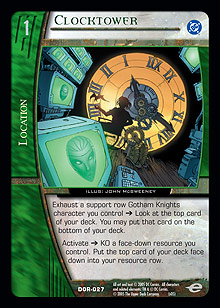 On the location side, we’re going to throw in one of my personal favorites, Clocktower. Since we won’t have much of a hand while playing this deck, we will need whatever tricks we can find to help us cycle through it. Moreover, I have found after playing Squadron Supreme that pretty much every card I draw after turn 4 goes either directly into play or into the resource row. When you draw nothing but characters, you will end up putting at least one (if not both, thanks to reservists) into the resource row. Thus, Clocktower is a great choice because it will replace these characters with potentially beneficial cards for later turns. Moreover, Clocktower can put those characters into the KO’d pile where they can easily be retrieved later with Hibernaculum.
On the location side, we’re going to throw in one of my personal favorites, Clocktower. Since we won’t have much of a hand while playing this deck, we will need whatever tricks we can find to help us cycle through it. Moreover, I have found after playing Squadron Supreme that pretty much every card I draw after turn 4 goes either directly into play or into the resource row. When you draw nothing but characters, you will end up putting at least one (if not both, thanks to reservists) into the resource row. Thus, Clocktower is a great choice because it will replace these characters with potentially beneficial cards for later turns. Moreover, Clocktower can put those characters into the KO’d pile where they can easily be retrieved later with Hibernaculum.
Also, let’s go ahead and throw in a couple of equipment cards in the form of Airskimmer. Since most of our early game will be off-curve, Airskimmer is a logical choice to help us fill in potentially lost resource points. In addition, Airskimmer can easily be discarded as a free Flying Kick, so to speak.
Before we get to our characters, let’s take a look at what we have so far:
4 Council of Power
4 Behavior Modification Device
2 Marvel Team-Up
4 Answer the Call
4 Hibernaculum
4 Clocktower
2 Airskimmer
Now for the fun stuff—our cast of characters! As I mentioned earlier, our early game will be largely off-curve to ensure that we have four characters on the board with which to activate Council of Power. As such, our complement of 1-drops will be rather large. Let’s take a look at our possible choices at 1:
Lana Lang, Manhunter Sleeper: While her effect is not helpful to our deck design, the fact that she has concealed could be very helpful. We will need a Manhunter character on the board at all times and we can’t always rely on a team-up. Therefore, we will put in three copies.
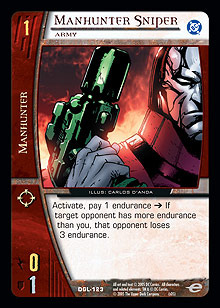 Manhunter Sniper: Okay . . . so we have a character with a mediocre burn effect for our burn deck. What’s important, however, is that Manhunter Sniper is an army character, so it won’t suffer from uniqueness issues. As such, we will include nine copies (mostly to ensure our team-up).
Manhunter Sniper: Okay . . . so we have a character with a mediocre burn effect for our burn deck. What’s important, however, is that Manhunter Sniper is an army character, so it won’t suffer from uniqueness issues. As such, we will include nine copies (mostly to ensure our team-up).
Ape X: While Ape X’s effect is kind of contrary to our deck’s goals (since she puts a free equipment card in hand), it’s hard to say that a free Airskimmer is a bad thing. We’ll toss in two of Ape X.
Doctor Decibel: Not a bad 1-drop. It has no real utility with the deck, but it can’t hurt to have extra options. Let’s include two of the good doctor.
Quagmire: Now that’s what I’m talking about! Not only does he fit the 1-drop requirement, but he can also be discarded in the later game to create potential stunbacks on opposing attackers. We’re definitely going with four of Quagmire . . . Giggitty giggitty!****
Thermite: Yuck! Thermite is great for keeping an opponent on an even card pace with you. However, we want our opponents to have as many cards in their hands as possible. So, Thermite is out.
Now that we have our all-important 1-drops set, let’s take a look at the remaining cast of characters:
Lacuna: One great way to improve our chances of hitting a team-up is to throw in one of the game’s premiere team-up tutors. While one can argue that Moonglow would be more effective in this role (especially since Moonglow is Squadron Supreme), Lacuna has the advantages of being a 2-drop and of bringing the team-up directly into play. Two copies.
Shape: Shape good! Shape want to be in deck! Many players will argue that Foxfire is a better 2-drop for the no-hand Squadron Supreme strategy. But honestly, I can’t see making a Squadron Supreme no-hand deck without this guy because he is so big in the late game. With a little help, Shape can take down 4- and 5-drops in the later turns. So, we’ll toss in a couple copies of our amorphous pal.
Golden Archer: While Blue Eagle is better from a board control perspective, Golden Archer fits the burn theme rather nicely. Assuming that you can empty your hand by turn 4, he’ll burn your opponent for 6 endurance loss each turn. Add in the damage your opponent will already be taking from Council of Power, and Archer can spell a quick end to the game. Four copies.
Albert Gaines ◊ Nuke: Given the nature of the deck, your opponents will resort to one of two options to deal with Council of Power—either attempt to empty their hands quickly to prevent the burn, or do nothing and lose quickly. Assuming they take the former route, you are in a much better position to control the game, as your deck is designed to operate with few cards in hand. Nuke is a great example of this, as he is functionally the size of a 6-drop in this deck. Given that he is also a reservist, three copies should be enough to ensure his presence in later turns.
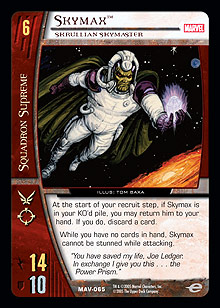 Skymax: It’s an incredible card, period! Not only does he combo well with and Hibernaculum, but also his recursion effect almost guarantees his availability on turn 6 to ensure that you hit your late curve. The fact that he’s got a massive 14 ATK and can’t be stunned while attacking (assuming you accomplished your no-hand goal) is just gravy. Three copies.
Skymax: It’s an incredible card, period! Not only does he combo well with and Hibernaculum, but also his recursion effect almost guarantees his availability on turn 6 to ensure that you hit your late curve. The fact that he’s got a massive 14 ATK and can’t be stunned while attacking (assuming you accomplished your no-hand goal) is just gravy. Three copies.
Power Princess, The Last Utopian: Our final two slots (and, oddly enough, the only rare in the deck besides Council of Power) go to The Last Utopian, who has an effect that nearly mirrors our deck’s theme card. Power Princess can clear the way for subsequent attackers to do breakthrough endurance loss, thus sealing the game.
Now let’s take a look at the final build:
The Supreme Council of Power [60 cards]
Characters [36]
3 Lana Lang, Manhunter Sleeper
9 Manhunter Sniper
2 Ape X
2 Doctor Decibel
4 Quagmire
2 Lacuna
2 Shape
4 Golden Archer
3 Albert Gaines ◊ Nuke
3 Skymax
2 Power Princess, The Last Utopian
Plot Twists [18]
4 Council of Power
4 Behavior Modification Device
2 Marvel Team-Up
4 Answer the Call
4 Hibernaculum
Locations [4]
4 Clocktower
Equipment [2]
2 Airskimmer
Obviously, our mulligan is for a copy of Council of Power. Once we have that up and running, we should be set for the remainder of the game (barring a Have a Blast! or the like).
There may be potential for some other “tech” cards, such as Foxfire, Rocket Central, or Break You, which could improve the overall strength and consistency of the deck.***** However, I’ll leave that to each player’s personal tastes.
That concludes the first-ever edition of Breaking Ground. I look forward to many more jank discussions in the near future. If you have a card (or combination thereof) that you think would be a good candidate for “breaking,” feel free to send your suggestions and ideas to BigSpooky1@hotmail.com.
* In the tradition of past Metagame.com writers like Danny Mandel (who I have never personally met, but have been told is really annoying), I decided to continue the practice of asterisk footnotes. Anyway, BS stands for BigSpooky . . . though some of you out there may have different opinions on the matter.
** Or throwing heavy objects at you, as is often the case when I try out a new deck.
*** Or, as my team likes to say, “Batow-ian standards.”******
**** It’s a Family Guy thing.
***** Break You is an ironic choice, given the name of the column.
****** I hereby promise all readers of my column that I will, at the very least, attempt to belittle Tim Batow at least once per week. I know he’d do the same for me.*******
*******I also hereby promise to cut down on the number of footnotes in future columns . . . I got a tad bit carried away!